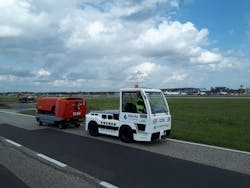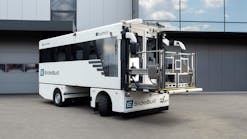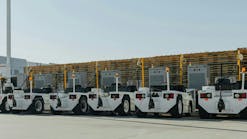Alternative Energy’s Emergence in Europe
As the world increasingly transitions to electric vehicles in order to combat climate change, ground support vehicles powered by renewable energy play a key part, due to their use in the 24/7 transportation of people and goods. Indeed, in recent years there has been a marked increase in the aircraft ground handling industry as to the potential of renewable energy powered ground support equipment (GSE).
Environmental Conscience
“Many ground support providers have embarked on strategies to use electrically powered GSE (eGSE) instead of conventional fossil fuel powered ones as an important part of their environmental sustainability responsibilities,” says David Burgess, vice president of global fleet management at Swissport. “We are a leader in this respect with a declared fleet strategy to have at least 50 percent of our motorized fleet powered by eGSE by 2025.”
Pure battery electric vehicles and fuel cells offer key benefits over diesel-powered vehicles in terms of environmental impact. According to Joe Blanchard, vice president of service at Plug Power, fuel cell vehicles (FCEV) – like those that were put into field trials at Hamburg Airport in Germany in 2019 – specifically offer greater range and simpler infrastructure scalability over pure battery electric vehicles.
“Currently, we are at the nascent end of the ramp to the electrification of the entire logistics ecosystem. The electricity and hydrogen infrastructure systems are the fuels for these electric vehicles and must evolve at the same rate to support the growth of electric vehicles,” he says.
“The development of hydrogen-powered GSE, and indeed biofuels, is still in its infancy with products in the conceptual stage of product development. We are always alert to new technologies and we are watching the development of hydrogen powered GSE with close interest,” says Burgess.
Fuel cell ground support vehicles are stock electric tractors made by various equipment manufacturers, except that their batteries have been replaced with zero-emission fuel cell engines like ProGen built by Plug Power.
“They tow up to 50,000 pounds in all weather for thousands of hours with zero emissions and show that hydrogen-powered vehicles and their fueling stations are safe to operate in an airport environment,” says Blanchard. “Refueling is accomplished in 3-4 minutes, similarly to diesel fills, and at stations like gas stations that can be located in convenient spots around the airport. Original equipment manufacturers of ground support equipment are introducing more electric platforms every day.”
Operational Benefits
In addition to the well-known environmental benefits of eGSE, there are cost and operational benefits too that must be accounted for.
According to Burgess, the main proven benefit is reduced maintenance and repair costs.
“There are less things to check during preventive maintenance inspections (PMI), meaning a faster turnaround for PMIs compared with fossil fuelled equipment. There are far less components to fail so the cost of spare parts is reduced quite substantially,” he says.
In addition, charging stations can be located closer to operational activity on the ramp than fuel stations.
“This means that there is less distance to travel for refueling/recharging interventions and thus more working hours available for operators to carry out their core operational business,” says Burgess. “An additional benefit is that the latest eGSE using CAN bus technology and electronic control units not only reduces the amount of copper wiring but is also better for efficient fault diagnostics and technology upgrades.”
Among the reasons whereby airports benefit from using FCEVs instead of diesel-powered unit there is the fact that the energy efficiency of a FCEV is 45 percent compared to high 20s for diesel-powered equipment, observes Blanchard.
“This includes energy recovery during regenerative braking. FCEVs have decreased maintenance costs due to the elimination of oil changes and starter replacements. Because there are very few moving parts, FCEV reliability and availability is greater,” he says. “There is also the elimination of environmental concerns using zero emission FCEVs. Operators of FCEV at airports report improved performance and user experience even aside from the lower noise and lack of diesel emissions with these solutions.”
Limitations
Currently, some limitations have prevented universal adoption of eGSE.
“There may be some applications requiring too much power or energy to be most effective with electric or fuel cells,” says Blanchard.
For Swissport, the main constraint preventing the company from ordering even more eGSE than it currently does is the lack of charging infrastructure at airports.
“While some airports are very helpful in providing charging infrastructure to support their own environmental strategies, there are many that do not. They cite various reasons such as lack of adequate space to create charging stations in already congested airports, while some state they are operating right at the limit of the airport’s power supply; meaning that requirements for additional power have to be very carefully managed,” says Burgess.
“Wider adoption would be achieved if airports were fully supportive and readily provided charging stations at various points around the airport. For example, why not utilize the power source already available for passenger boarding bridges as a dual source by also providing a charging station for opportune charging when the boarding bridge is not in use?” he continues. “Conceptually, it would be great if airports had multiple charging points around the airport as close as possible to operational activities. Certainly, for new airports or new terminals the provision of charging points should be a design feature of the master plan. Government grants would also encourage ground support providers to ramp up the procurement of eGSE.”
Overall, as evidenced in the proliferation of electric GSE models over the last few years, the investments are now being made more than in the past to electrify airports.
“The technology is currently available to transition every airport to electric vehicles, whether battery or fuel cell-powered. An ever-growing numbers of airports, as well as companies that operate at airports, are investing in design and infrastructure projects to make this change a reality. Governments, GSE OEMs and airport operators are all moving the adoption forward and removing barriers. In some airports, they are already investing in green energy and can even produce their own hydrogen providing true zero emissions,” says Blanchard.
More Extended Adoption
Exposure, visibility, support from companies and governments, where appropriate, and cost-effective hydrogen are the main requirements for a wider adoption eGSE, observes Blanchard.
“Hydrogen is a critical enabler to the electrification of airport GSE with the range needed to perform efficiently during the constant busy-ness of larger airports,” he says. “As more hydrogen fuel is amortized over the capital expenditure, the all-in price drops. As ports expand, requiring more hydrogen, little is needed to expand the site to accommodate these greater fuel demands.”






